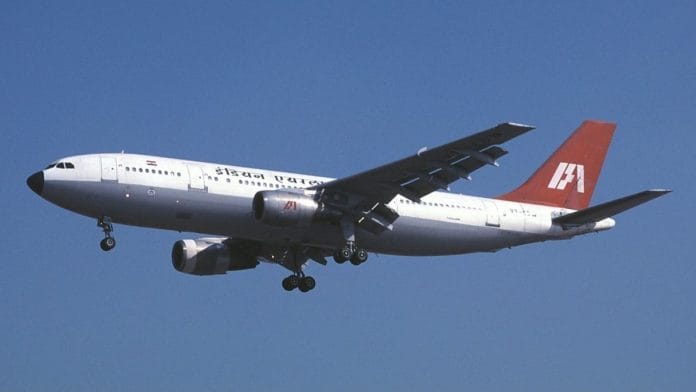New Delhi: The Central Intelligence Agency, United States’ foreign intelligence service, had been informed by sources in the Islamic extremist organisation Harkat-ul-Ansar that the group was contemplating “terrorist actions against civilian airliners”, according to a secret memorandum prepared in August 1996.
The warning, which mentions threats to both passengers and VIP aircraft, had come three years before the hijacking of an Indian Airlines flight, which was flown to Kandahar in Afghanistan, to secure the release of jailed Harkat ideologue and organiser Masood Azhar Alvi.
“Attacks on civilian aircraft in India could well involve Western casualties,” the now-declassified memorandum noted, “given the large number of Western tourists in that country.”
The memorandum recorded that the Harkat-ul-Ansar had kidnapped thirteen hostages, twelve of whom were Western nationals, since early 1994, when Indian authorities had arrested Azhar near the village of Matigund, together with the organisation’s regional military commander Sajjad Khan, also known as Sajjad Afghani.
Following these kidnappings, the memorandum recorded, Pakistan’s Inter-Services Intelligence Directorate had scaled back its financial assistance to the Harkat, which the CIA estimated had stood between $30,000 and $60,000 per month.
The decline in ISI funding was “probably out of concern that its ties to the group will prompt the United States to place Pakistan on the list of state sponsors of terrorism”, the document said.
There is no evidence in the existing declassified CIA documentation on whether any pressure was mounted on Islamabad to terminate the hijacking plot. There is also no documentation to suggest that New Delhi was given any specific warning of an enhanced threat.
“There was some general suggestion of a threat to aviation,” a retired Research and Analysis Wing (R&AW) official, who dealt with Kashmir-related issues at the time, recalled, “but I have no memory of any specific intelligence being shared on a plot.”
Following Azhar’s arrest, Harkat-ul-Ansar began a campaign intended to pressure Western governments into ensuring his release. The first victims were United Kingdom citizens Tim Housego and David Mackey, for whose release the Harkat-ul-Ansar demanded the release of Azhar and his fellow jihadist, Nasrullah Langriyal.
The two men were, however, released unharmed after 17 days, after intense diplomatic pressure was brought upon Islamabad.
Later that year, in October 1994, former London School of Economics student Ahmed Umar Syed Sheikh—who was eventually released as part of the Indian Airlines hostages-for-terrorists exchange in Kandahar—organised the abduction of four British nationals from a guest house in New Delhi’s downmarket Paharganj.
The victims were driven to a safehouse near Saharanpur in Uttar Pradesh, where intelligence officials located them on 31 October. A shoot-out followed, in which Uttar Pradesh Police commando Abhay Singh Yadav was killed. All four hostages emerged from the rescue operation unharmed.
Finally, on 5 July 1995, a shadowy outfit called Al-Faran took five Western tourists hostage from Pahalgam. The body of one of the hostages, Norwegian national Hans Christen Ostro, was found decapitated and the word “Al-Faran” carved into its belly. A second declassified CIA note suggested that even then, the United States was aware Al-Faran was a front organisation for the Harkat-ul-Ansar.
The CIA memorandum recorded that the remaining hostages, Keith Mangan and Paul Wells of Britain, Donald Hutchings of the United States and Dirk Hassert of Germany were shot dead on 13 December 1995.
Following the reduction in funding from the ISI, the Harkat-ul-Ansar was “attempting to expand its ties to foreign supporters of international terrorism that are virulently anti-US and may further encourage the group to attack U.S. interests”, according to the document.
A complete cut-off of ISI aid, it continued, “would make the group more likely to accept money from anti-US international terrorist supporters such as [al-Qaeda chief Osama] Bin Laden”. It was also speculated that pressure might make the Harkat-ul-Ansar, which was linked to a 1995 coup attempt against Prime Minister Benazir Bhutto, turn against the Pakistani state.
Experts like Don Rassler have said that the relationship between al-Qaeda and Azhar dated back to at least 1993, when the jihadist leader travelled to Somalia to assist Islamists fighting against the United States. Al-Qaeda also deployed several key commanders at the time to train and assist Somali jihadists.
In his book titled ‘A to Z of Jehadi Organizations in Pakistan’, Pakistani scholar Muhammad Amir Rana wrote that Bin Laden and Azhar also held two meetings during this period, one in Kenya and the other in Saudi Arabia. The two organisations also fought alongside the Taliban in 1997 against the Afghan military.
The United States finally designated the Harkat-ul-Ansar as a Foreign Terrorist Organisation in 1997. The outfit responded by adopting the names of two groups that had united to form it, the Harkat-ul-Jihad-e-Islami and the Harkat-ul-Mujahideen.
Following al-Qaeda’s bombings of United States embassies in Dar-es-Salaam and Nairobi in August 1998, the terrorist group’s facilities in Afghanistan were bombed in retaliation. Those facilities were shared with the Harkat-ul-Ansar.
After his release in Kandahar, Azhar reunited the various Harkat-ul-Ansar factions to form the Jaish-e-Muhammad, taking over their assets and office facilities with the active assistance of the ISI.
(Edited by Mannat Chugh)
Also Read: IC 814 hijack was a victory for Masood Azhar—and the moment of his strategic downfall






